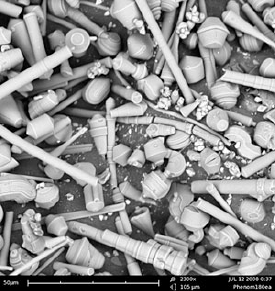Dec 15 2008
One of the challenges of modern nanotechnology is not only the engineering of nanoscale materials and particles, but also assembling and integrating them into larger-scale structures, devices, and systems.
 Technology Image: Scanning Electron Microscopy of the nanoporous particles showing the variety of the shapes typically found in biological world.
Technology Image: Scanning Electron Microscopy of the nanoporous particles showing the variety of the shapes typically found in biological world.
Nanoporous silica colloidal particles are well-defined nanostructured systems which are self assembled from nanoscale units into larger hierarchal structures, shapes of high complexity that are typically observed in biological worlds.
Our research focuses on the fundamental mechanisms that drive such morphogenesis of these nanoporous particles. From a structural point of view, these particles are sorts of very dense arrays of nanoscale cylindrical channels running in parallel inside silica matrix. The diameter of these channels can be chosen from 2 to ~20nm. Various molecules can be confined inside such nanochannels. For example, fluorescent organic dyes can be physically (non-covalently) encapsulated inside self-sealed nanochannels in micron size particles (scaling down to 30 nm particles has also been demonstrated). Nanoscale confinement of the dye molecules allows us to attain rather non-trivial properties of these nanocomposite particles. Our team is also able to demonstrate ultra-bright fluorescent silica particles, which are up to 260 times brighter that similar size brightest possible colloidal agglomeration of quantum dots. Combining different molecules, one could build a microscopic device/particle with complex response to external stimuli.
From the application side, Dr. Sokolov informs NWN that his team (graduate students, D. Volkov and J. Benson) is finishing development of new type of sensors using these particles. In the beginning, these sensors will detect temperature of the environment. “We call this project "micro thermometers." Each particle can "measure" the temperature by changing its gloving (fluorescence)." He tells us that it is important to note that the novelty is in the principle of the sensing. It works due to nano-confiment of fluorescent dyes inside the silica channels. The dyes separated from the porous matrix (in water, for example) do not show strong temperature dependence. The work is supported by the National Science Foundation.
One of the possible applications of these thermometers would be the measurement of temperature distribution inside buildings (by dispersing the particles in air and measuring fluorescent light coming from them). It would allow engineers to build more energy-efficient buildings. However, this requires the micro-thermometers to be sufficiently cheap to be practical. Making such particles and development of practical methods to map temperature flows in air indoor is another application that we are doing together with Clarkson University Professor Douglas Bohl (supported by Environmental Protection Agency, a subcontract through the Center of Excellence of Syracuse University).